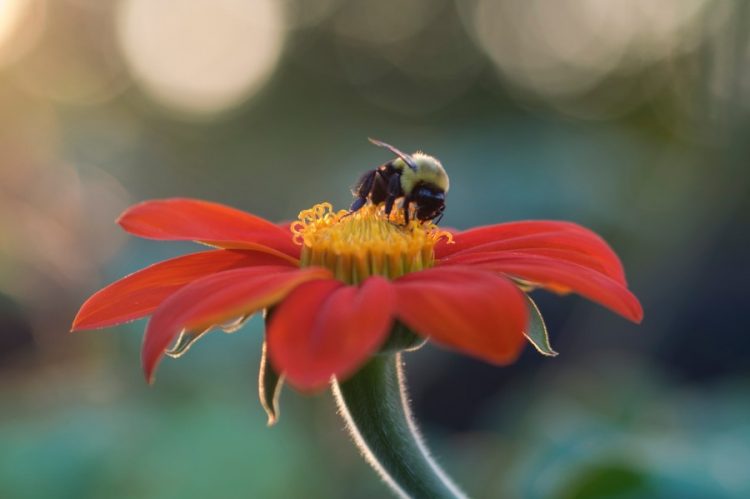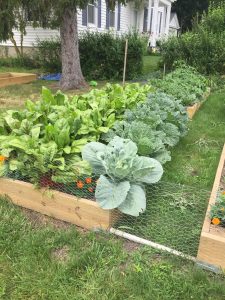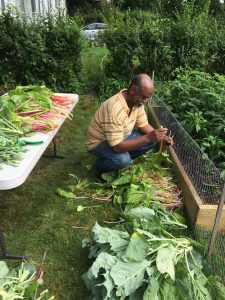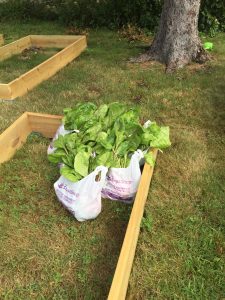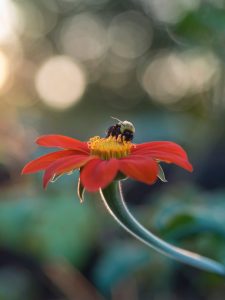Why the Peace Garden Project?
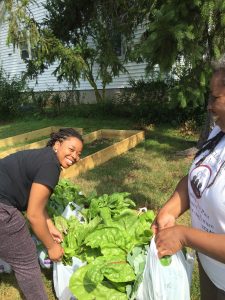
On Harvest Day, produce was bagged with recipe cards. Each family received enough produce for at least two plant based meals for a family of four.
I was raised in the south in a pretty fundamentalist Baptist Church, and I have a Muslim sister. Though my beliefs are no longer fundamentalist, and I am no longer Baptist for years, my sister’s faith was the thing we as a family didn’t talk about. This decision I believe was born out of a lack of understanding about what it meant to be Christian, but also a lack of understanding about the Muslim faith, and the Abrahamic traditions. As I journeyed into the world of interfaith work, I began to better understand my own faith, Islam, Judaism, and my sister. The thing that has become the most apparent to me during the Peace Garden project is just how much work still needs to be done around understanding and loving our neighbors. My personal experience is that when we truly work to understand the faith systems and people that are different from us, then we are able to begin to see real change in the communities where we work and serve.
The New Rochelle Peace Garden Project (NRPG) works to build cultural competency in our community while working on issues of food justice. The Peace Garden Project was started in an effort to work against the rising tide of anti-semitism, racism, xenophobia, and homophobia in the community while looking at what it means to really build and be community from a Christian perspective. As you’ll see from the interviews, culture and personal story have been instrumental in why people are engaged in the project,
https://youtu.be/cDD1r9gjGB0
Until 8 years ago there were two United Methodist Churches in the Community. One was the Black UMC, and the other was White. It wasn’t just faith that was merged, it was race, class, ethnicities, and socio-economics. Our churches our not unlike our families, in that even with the best intentions, misunderstandings can and often do occur, especially when there are differences around which there is a lack of understanding. The NRPG addresses cultural competency on micro and macro scales while building community through addressing food justice.
The NRPG was started at New Rochelle United Methodist Church (NRUMC) in the Spring of 2017. NRUMC is located in New Rochelle, New York (NRNY). NRNY is a suburb of New York City (NYC). The population of NRNY is 79,637.[1]Forty percent of the community are racial/ethnic minorities, and 16 percent of the population is living at/below the poverty level. Though New Rochelle is a diverse community and had one of the first planned integrated communities in the country there are still pockets of segregation present. The Peace Garden Project addresses diversity, and cultural competence while doing the work of food justice. The numbers of people living at or below the poverty level in New Rochelle is above the national average; Westchester County New York where New Rochelle is located is the richest county in the state. This program addresses food justice not just among people that have been identified as living below the poverty level, but is also making sure that the working poor and underemployed, the population that is living from paycheck to paycheck, and those people who remain unidentified have adequate access to fresh food.
The NRPG works to ensure food security in the communities where this problem is the greatest. 41.2 million Americans live in food insecure households.[2]This is 16 percent of the population or 110.8 million people. An additional 7% of people regularly experience low food security.[3]Though the majority of areas in NRNY don’t qualify as food deserts, they do qualify as food mirages.[4]During the 2017 growing season, the NRPG was maintained primarily by members of NRUMC. There was not system for screening persons who received the produce. Food was provided to individuals, families, local food banks and shelters.
Project Organization
The Peace Garden project was divided into three phases. Phase 1 was the initial garden. The initial phase raised a number of questions which included: 1. Will we be able to successfully grow food in this community? 2. How much food will we be able to produce? 3. Will the food we grow be enough? 4. How many people will be needed to work the garden? The answers to these questions were as follows: We were able to successfully grow food. We produced food for more than fifty families, and additionally provided food to a local shelter and a local food bank. Though we exceeded our early expectation, we did not grow enough food to meet all the need of the community. We had adequate help in the garden. There were approximately 25 persons that participated on a regular rotating basis in the garden. The work in the garden was governed by the principle that, “No one works alone.” This principle ensured that we were constantly building relationship while working in the garden, and fostered the idea that as disciples we don’t do the work alone, but that it can only be done in community.
Phase 2 of the project included creating the garden beds, and putting the seeds and plants in the ground. There was also an eight-week movement series that focused on the connections between our spirituality and movement that included Yoga, dance, and general fitness classes as a part of our approach to total body wellness.
Phase 3 of the project included a study of our faith, food, and social justice from Christian and Jewish perspectives. The spirituality sessions were team taught with Rabbi Zach Sitkin from the Beth-El Congregation, New Rochelle.
(Photo by Aaron Burden)
A Morning in the Garden
“It’s dead.” It was a definitive statement from the 7 years old boy.
We gathered around to take a look at what he was talking about. It was a bee. This led us to a conversation about the lifecycle of bees, and the contribution of bees to the environment. The children were sad that the bee was dead. The children were given the opportunity to talk about how the death of the bee made them feel, and why. As our conversation about death came to a close, the little boy that noticed the bee reached his hand toward it in what I couldn’t tell was an effort to grab the bee, or to flick it from the flower.
“What are you doing?” I asked him. He looked up at me sheepishly and said, “I was going to move him.”
“Can we let him stay? He’s not hurting anything.”
We continued to look at the bee in silence when the bee flew off. As the bee flew off and the children began to exclaim, “It’s alive! It’s alive!”
“So, was it dead?” One of the children asked.
The question led us to a conversation about Jesus, our Christian faith, and the resurrection, and what it means to love our neighbors, and to be in community with people that are different from us. Through working together and the sharing of story, we were able to have conversations about family, creation, lifecycles, birth, and transformation. This is the type of experiential learning that you can only get in an outdoor setting with extemporaneous activity that allows for questions, and self-discovery while encouraging all involved to think about their role in these processes.
The children and adults that worked in the garden had fun. Many of them pulled their first carrots, and picked their first Swiss chard and kale. They also got to see and participate in the growing process from start to finish. All were excited to plant seeds and then watch the seeds grow. They were even more excited to learn that they were able to help families in need in the community. Even the youngest children that participated understood that they were helping other children their own age(s) have enough to eat and were able to have meaningful spiritual and educational opportunities in the garden.
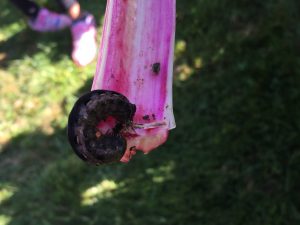
Being in the garden led to discussions about lifecycle processes in humans, insects, and animals for children and adults.
Where Faith and Food Collide
The Rev. Dr. Martin Luther King Jr. said, “Injustice anywhere is a threat to justice everywhere.” Food justice is an ill that is present in every community in the United States and is marked by those who have too little, and others who have too much.
As an entry into why food justice should matter in faith communities we can look to Matthew 25:31-41. In this passage of scripture is the parable of the sheep and the goats. As a part of the parable the crowd asks the question, “Lord, when was it that we saw you hungry or thirsty or a stranger, or naked, or sick…” to which he replies, “For I was hungry and you gave me something to eat, I was thirsty and you gave me something to drink, I was a stranger and you invited me in.”[5]This scripture is one that can begin to help the reader understand that our relationship to food can be good, sinful, or a combination thereof. Many who have worked in the NRPG believe that it is possible to show others love and compassion through the sharing of food.
Additionally, there are biblical texts that provide guidance about when sharing/not sharing food becomes sinful. Isaiah 58:7-10 reminds us that when we share our food with the poor and provide shelter for the homeless God watches over us.[6]Additionally, Luke 3:11 says, “…whoever has food must do likewise,” Just as we are challenged to share with those in need, we are also cautioned against gluttony. Proverbs 25:27 says, “It’s not good to eat too much honey…” and Ezekiel 16:49 reminds us, that included in Sodom’s sins were pride and, “excess of food.”[7]These scriptures help us to understand how through the sharing of food, we have the ability to both positively and negatively impact relationships and our own spirituality. Our teachings about faith and food have included food justice from Christianity and Judaism perspectives. A key component of the Peace Garden Project is Interfaith dialogue. As our dialogues and relationships with neighbors has increased, we have been able to begin to live more fully into the command to, “love our neighbors as ourselves.”[8] Providing for our neighbors in need is a concept present in both Christianity and Judaism. See the clip below for a lesson from Rabbi Zach Sitkin about Food Justice and Judaism.
Self-Reflection
I was only slightly optimistic when we began early talks about the NRPG. I tried to start a Peace Garden in another city at another church and the initial responses and concerns of the people were: “People might steal our vegetables,” and “it might make our property look bad.” It was an area with just as many, if not more poor people than New Rochelle. That experience, though disheartening made me realize when we started NRPG that it would be important for us to gather as many community partners as possible, and that it needed to be the church’s idea. Two of the reasons we will be able to expand for the 2018 growing season is because of the partnerships we have built in the community around the garden through this project; The partnerships and additional supports were also easier to gather with a successful year under our belts. The actual outcomes from the garden in 2017 were:
- Participants gained a greater understanding about the similarities and differences between Judaism and Christianity.
- Fed more than 50 families in the community of NRNY.
- Provided food to a local shelter and a local soup kitchen.
- Created new community partnerships.
- A visit to the Yale farm to better understand how the Peace Garden project could further engage the community.
- Created new and deepened existing relationships.
- Created jobs for 2018.
What’s Next?
Though the 2017 garden had a late start, it didn’t stop us from feeding more than 50 families. We started with six garden boxes and increased to 11 over the course of the growing season. There were three large harvests with three smaller harvests in between. We learned a great deal of lessons this year about the types of produce that are viable in the community, and things we need to do to maintain the garden as organic while thinking about pest control. We have also had the opportunity to explore what it means to live our faith in nontraditional ways, and what it means to be in community with people of different faiths and backgrounds. The garden has generated a lot of support from both the church and the larger community. The community partners that we have gathered for the 2018 growing season include the New Rochelle Mayor’s office, 5 faith communities, the local boys and girls club, the local high school, a network of doctors, 2 nurses, 3 personal trainers, 2 nutritionists, 3 professors, and 2 chefs.
Through this project, we have received a grant of $50000.00 and are being considered another smaller grant for $20000.00 to do additional youth programming related to the garden. The funding that we are receiving will allow us to increase the number of garden boxes from 11 to approximately 50. It will also allow us to make some of the boxes accessible for disabled persons, and will provide us with those tools necessary to develop the infrastructure. The funding will also allow us to strategically locate refrigerated boxes within the city of New Rochelle with free or low-cost produce, and will allow us to hire staff for the summer to assist with the work of the caring for the garden, organizing, and leading the spirituality development sessions, and to bring in guest speakers. Additionally, funding will enable us to provide stipends for college students that are working with the new ministry. It will provide us with the funds necessary to include picnic tables in the garden, and pizza grills for community pizza nights. During the 2018 harvest season, community dinners will be held weekly. Dinners will center on some theme related to faith and food. Participants will be able to work in the garden, choose their vegetables and then gather round a table to share a meal with others and discuss faith, while continuing in this process of building right relationships with our neighbors and the divine.
Conclusion
It’s not over. The work of the NRPG has only just begun. As people learn about the garden, they become increasingly curious about the work and the ways they can assist. The NRPG is challenging all who work there to explore their faith more deeply, and they are doing it with others in an environment that is safe and courageous for all persons.
[1] City-data for New Rochelle, http://www.city-data.com/city/New-Rochelle-New-York.html. (Accessed 26 June, 2016).
[2]Feeding America, Poverty and Hunger Fact Sheet. http://www.feedingamerica.org/assets/pdfs/fact-sheets/poverty-and-hunger-fact-sheet.pdf(Accessed 2 March, 2018).
[3]https://www.ers.usda.gov/topics/food-nutrition-assistance/food-security-in-the-us/key-statistics-graphics.aspx#foodsecure (Accessed 30 March, 2018).
[4]Food Mirages are places where there is plenty of healthy food, but people don’t have adequate access because of income restrictions. This phrase was first used by Rev. Heber Brown III.
[5]Matthew 25:35 (NRSV).
[6]Proverbs 25:27(NRSV).
[7]Ezekiel 16:49 (NRSV).
[8]Matthew 22:37 (NRSV).
(All videos were produced, filmed, and edited by Michelle Estelle Lewis. All photos unless otherwise noted are credited to Michelle Estelle Lewis).
